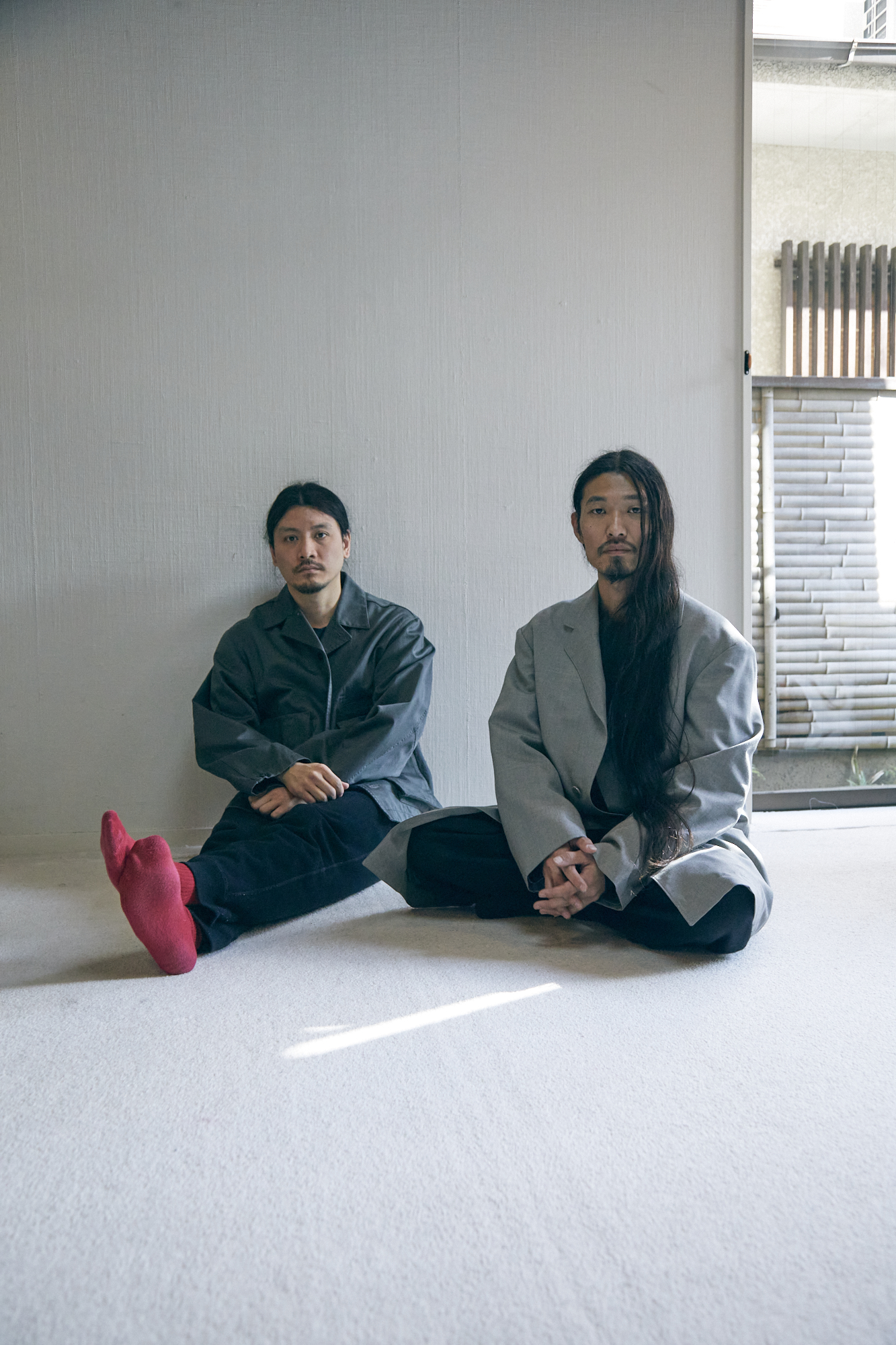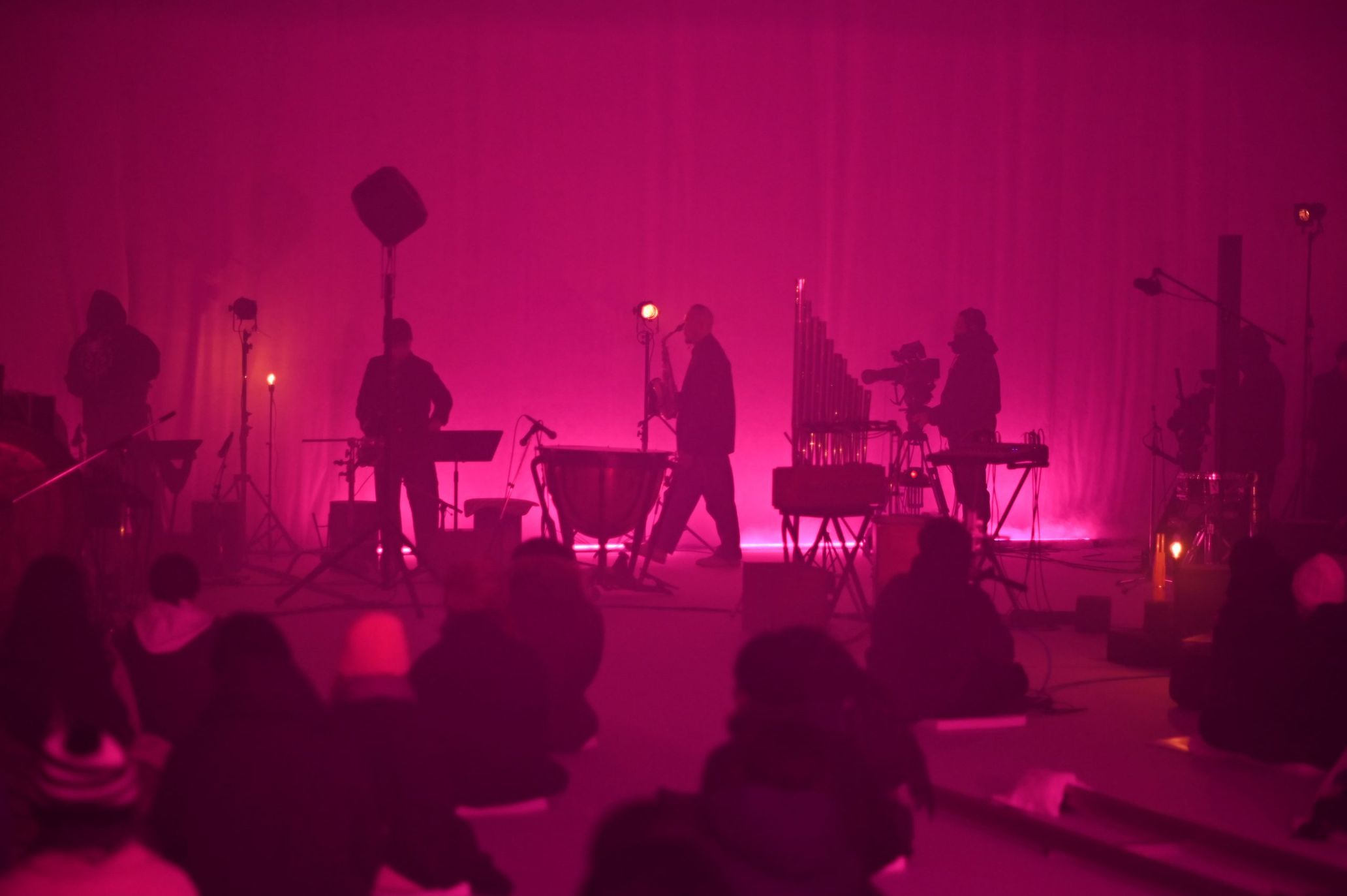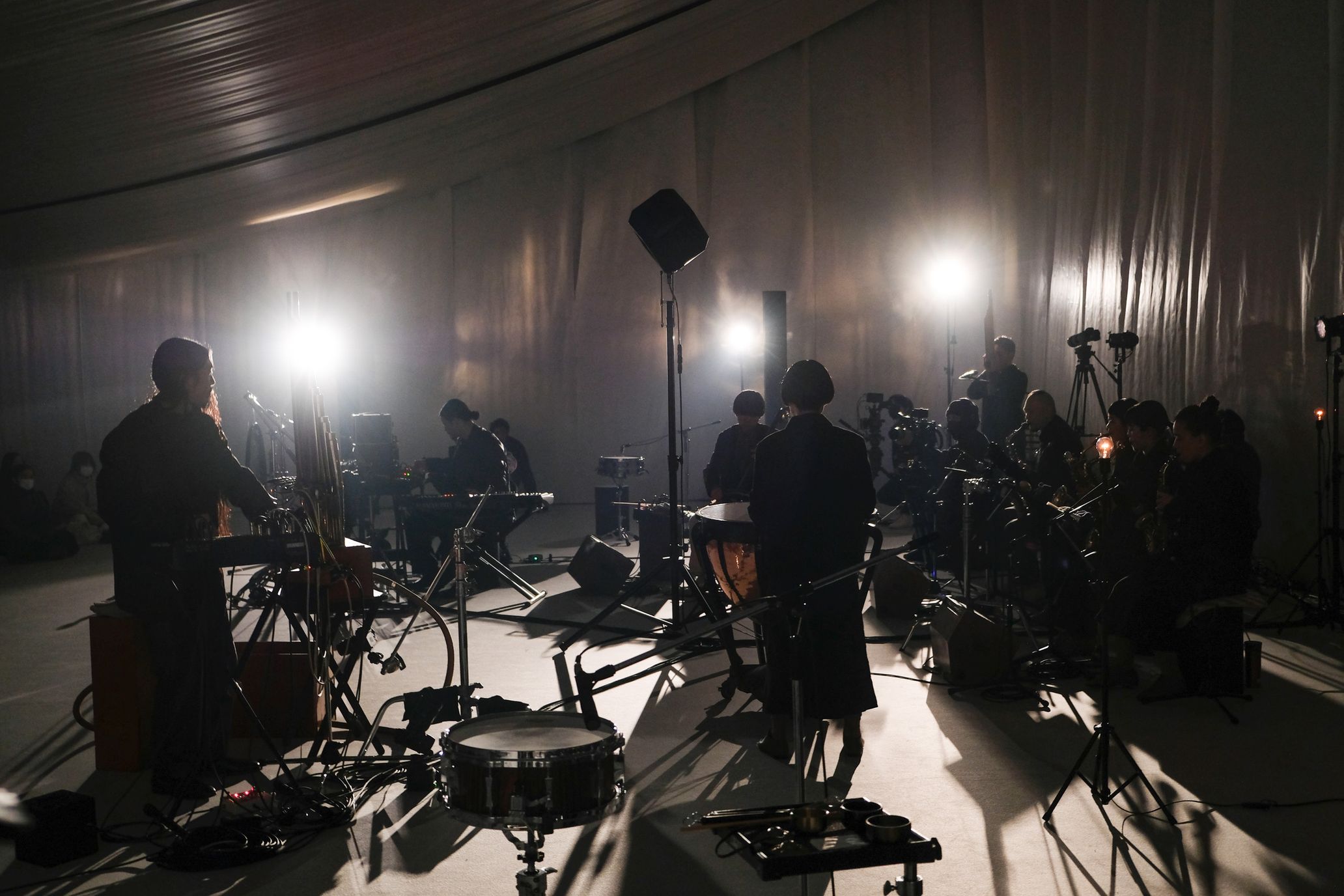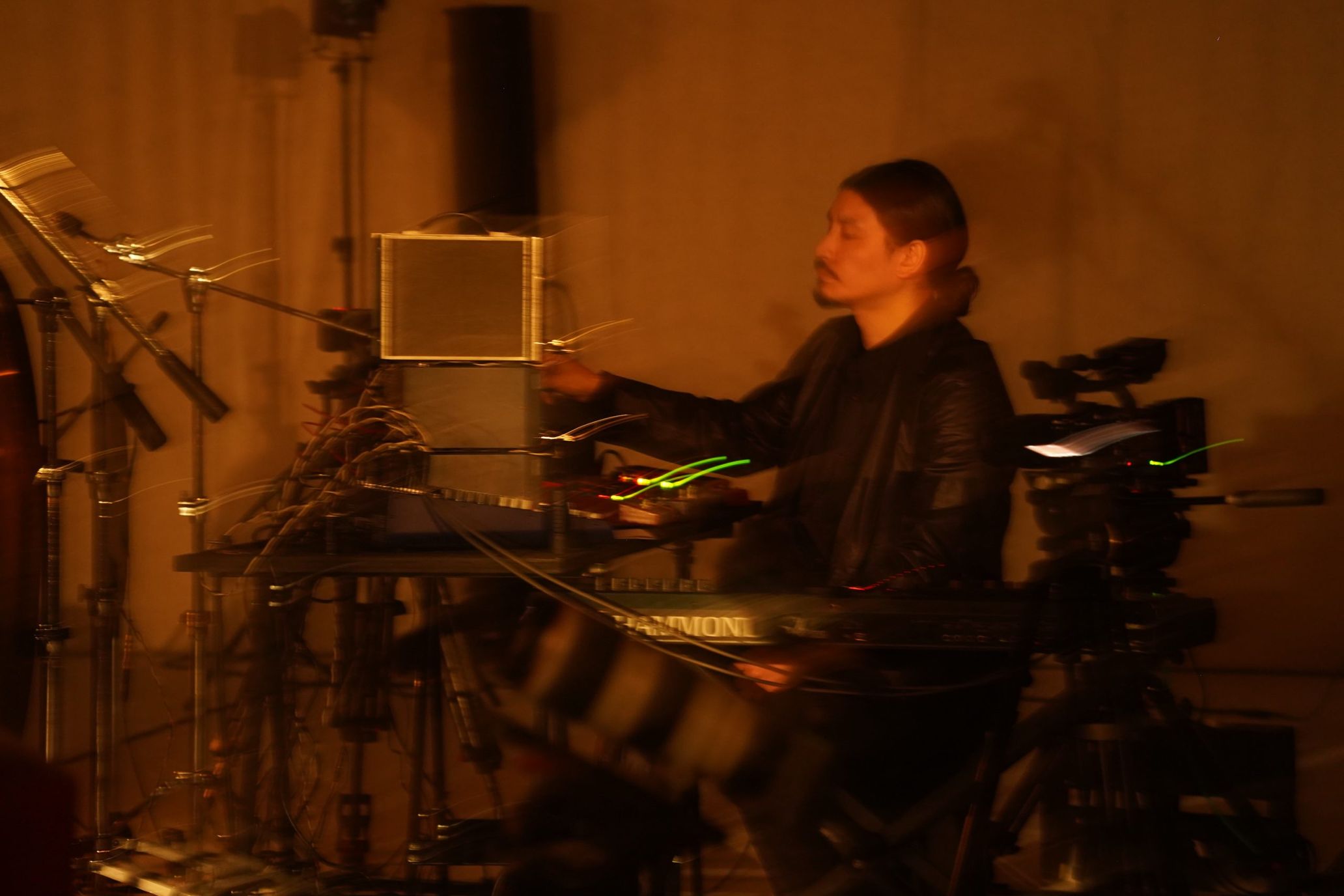On December 18, 2021, “INTERDIFFUSION A tribute to Yoshi Wada,” a concert dedicated to Yoshi Wada, a pioneer in the drone world who passed away in May of the same year, was held at an abandoned school in the mountains of Hokuto City, Yamanashi Prefecture. A special venue covered entirely with white cloth was set up in the gymnasium of a former elementary school about an hour’s bus ride from the nearest train station. Before the performance began, a mysterious purple light created an mystical atmosphere. Due to a severe cold wave that hit the mountainous area where the venue was located that day, the audience gradually lost sensation in their limbs. However, it was certainly an unforgettable audiovisual experience, as if they had wandered into an unworldly other world.
The concert featured a 10-member ensemble performing an 80-minute composition created by musician/composer Koshiro Hino and pipe organist/sound artist Yosuke Fujita (FUJI|||||||||||TA), who had collaborated on the piece for this occasion. The electro-acoustic drones that interdiffuse sounds were reminiscent of Yoshi Wada, while each player’s outstanding performance and sound manipulation designed the entire space, creating a subtle yet dynamic sound field. The addition of lighting that kept synchronizing/desynchronizing the sounds brought about an extraordinary time-space that resembles a religious ceremony, but is also like an immediate experiment.
What does it mean to face Yoshi Wada’s music in this day and age? Or what possibilities can we draw from it? In the second part of the special conversation between Koshiro Hino and FUJI|||||||||||TA, who were central figures in the tribute live show, they discussed the essence of tribute in “INTERDIFFUSION” and how they perceive their musical practices in relation to academic/non-academic and notions of music/art. We also asked them about their music recommendations to listen to alongside of Yoshi Wada.
Photography RiE Amano
The essence of tribute in “INTERDIFFUSION”
–I believe that there are many different approaches to give tribute to Yoshi Wada’s musical legacy. What elements of Yoshi Wada did you plan to incorporate into “INTERDIFFUSION” and how did you translate them into the relevant form of expression?
Koshiro Hino (Hino): There was little talk of “incorporating this element as a tribute.” For both myself and Fujita-san, Yoshi Wada is a very big part of our musical activities. So I thought it would be meaningful as a tribute to Yoshi Wada just to create a new work with that as a common understanding. Of course, in the process, I had to reexamine Yoshi Wada in my own way. For example, I used the relationship between the pipe horns and oscillators in “Earth Horns with Electronic Drone” (2009) as a reference, and I went through a process of trial and error to find out how a duo of Fujita-san’s self-made pipe organ and my oscillators could coordinate well. Then, based on the duo, we added other instruments and developed the concept of the music for an ensemble performance. However, such an approach itself was not that important to us, but rather the fact that a generation influenced by Yoshi Wada was creating new forms of expression was the most significant thing.
FUJI|||||||||||TA (Fujita): Yes, that’s right. Rather than incorporating specific elements, in the tribute, our first priority was to approach the music with Yoshi Wada in the forefront of our mind. Also, for me personally, the fact that I was able to perform with Hino-san for the first time because of Yoshi Wada itself was significant and valuable. It was only because of Yoshi Wada that I was able to create such an opportunity. So I thought it would be good for the two of us to simply create a new work together.
–Why did you decide to create a new work, rather than reenacting or rearranging Yoshi Wada’s works?
Hino: In my mind, there were two reasons: First, if we were going to perform Yoshi Wada’s work again in a tribute event, there must be other people who would be more suitable. In other words, there is Tashi Wada, the composer/performer who is Yoshi Wada’s son. So I didn’t feel the need to re-perform the piece myself. Another reason is that I imagined it would also be better for Yoshi Wada to have new music created by people who were influenced by him, rather than to perform the same piece again. So we decided to create a completely new piece as a tribute.
Fujita: That was an unspoken premise that we shared without having to talk about it.
Hino: Yeah. We didn’t even come up with the idea of a revival, but rather, we started by talking about what we should make. Even if Tashi Wada would not perform the piece again in the future, we would have created a new piece anyway. I think that any attempt by a third party to ruminate on Yoshi Wada’s work would be better served by a solid verification process in the academic realm. You know, we are only artists.
“Rigidly committed to the non-academic world as a starting point”
–For example, it can be said that it is only through academic investigation and research that we can carefully delve into the reenactment of past sound works, as pointed out by Tomotaro Kaneko, a scholar of auditory culture theory in his book “Japanese Art Sound Archive.” What do you think?
Hino: There is a man named Kazuhiro Jo, who is an associate professor at Kyushu University, with whom I have been teaching composition classes. In the “Generative Music Workshop” that I am conducting with Kaneko, we are reenacting Steve Reich’s “Music of Pendulums” and Alvin Lussier’s “Music of Long, Thin Wires” in their own way, and they are meticulously examining how acoustic phenomena are generated. Conversely, because excellent researchers like them can play the role of re-enacting, analyzing, and explaining past works, we feel that we must play our own role as people who create new works.
Fujita: I feel the same way. By the way, while you are working as an artist, you are also a part-time lecturer at Kyushu University. In terms of academic/non-academic, where do you position your activities?
Hino: Well ……, I certainly have a strong interest in the academic world. And I am actually teaching. However, I dropped out of college, and I am not what you would call academically educated. So I feel like I am in between the academic and non-academic worlds.
Fujita: What I found interesting about your musical practices is that you start from a non-academic point of view, while at the same time creating your works with an academic context in mind. You exert a presence in the academic world, but your work is based on the non-academic world. I think that is very important. There are very few musicians who work from such a position, and even if they wanted to, it would not be very easy to do so. I think it is possible because you have the ability to actually embody it. I think it’s amazing.
Hino: It is difficult to polarize academic/non-academic, but in reality, I feel that I am still not recognized from the academic side, and I think that there are some people from the non-academic side who may consider me to be an academic. But what is important in this context is that, as Fujita-san says, non-academic is the base of my work. I am sometimes called a contemporary composer these days, but all my projects, such as YPY and GEIST, are based on my experiences and ideas gained in the band. However, I also have a strong interest in academic analysis and methods of expression, so I would like to have both perspectives.
However, the more ambiguous the environment in which I am placed, the more difficult it can be to fit myself comfortably in a certain place. For example, I feel quite out of place in the academic world. And I have to express myself on the premise that my form of expression is not easily accepted within it. Of course, that difficult situation can inspire me, but actually expressing oneself in that situation can be painful as well. The same thing happens when I am in the dance music world. When I am placed in the context of techno music, I am totally different from it no matter what I do. Of course, I am interested in that context, but I don’t necessarily want to express myself in that context. However, depending on the venue or event, the audience is looking for techno, so I often feel I am not welcomed. So being in between the two is always accompanied by suffering. But because of that suffering, it is also a great joy when I am accepted. But working with Fujita-san on “INTERDIFFUSION” was a pleasant experience. That attempt itself was something in between.
Between music and art, or the difference between the two
–Yoshi Wada can be said to be somewhere between music and art. For both of you, do you position him as musicians or an audiovisual artist?
Fujita: I see him as a musically oriented artist. Of course, Yoshi Wada himself had a different perspective from a pure form of music, but in my mind, he is not positioned as an audiovisual artist.
Hino: It is difficult, isn’t it? Yoshi Wada is both an audiovisual artist and not an artist, and the same can be said about his music. He is not on either side of the spectrum, so I think he is somewhere in between the two. The fact that he shifted his main focus onto installation in the latter half of his career only makes it appear as though he has turned toward audiovisual art, but what he was doing was essentially the same.
–The practices of Hino-san and Fujita-san also fall somewhere between music and art. But how do you two view the difference between music and sound art?
Fujita: There are many ways to look at the differences. It is often said, for example, whether or not the artist is on site. If the artist is on site, the work can be categorized as a performance, and if not, it can be treated in the context of art as an installation. The latter would be called sound art, but that is not the absolute definition. There are performances in an art context, and even in music, there are many live performances where the player is not on site. So, it is just a difference in the context in which the expression is located. The other difference is whether the artist himself is presenting it as music, or whether he/she is trying to place it in the context of sound art.
Hino: I think so too. I am often attracted to works that fall somewhere between sound art and music, and that cannot be fully defined as one or the other. There is also the academic/non-academic issue I mentioned earlier. In the case of Yoshi Wada, he did his own practices sensorily, and the resulting works were either musically oriented or sound art-like. But this was only possible through his consistent non-academic attitude. In the academic world, most artists set a goal and an end point first, and then proceed with their work toward that goal. For Yoshi Wada, creating a self-made instrument called a pipe horn was not the first goal he set, but rather the interesting result of experimenting with various things. I think that only because sounds were recorded, they ended up in the format of music.
–Do you actually feel a difference between music and art as an institution when you place yourself in the specific site?
Fujita: I clearly do. For example, the Sapporo International Art Festival 2017, in which I participated with the installation work “CELL,” which made audible the sound of horsefly larvae, clearly existed as a site in an art context. Therefore, the approach is completely different from that of a live performance at a music site. Considering the institutional differences, I feel that I am a person who feels closer to music, and I end up wanting to perform at music venues. I feel safer there.
Hino: I have almost no experience working in the field of art. We have basically done everything ourselves, from fundraising to site preparation for stage performances, and I have almost never been invited to do anything other than music. However, I am currently working on an installation. I am also a person feels closer to music, but I think I would be able to find a new side of myself only through working in an art context.
Fujita: There are kinds of works that are only possible because they are in the form of installations, not live performances. The way of perceiving the time axis of a work also changes between a live performance and an installation, so I think there are many things that can be challenged in this kind of sound art field. Personally, however, I don’t think I am suited to places like museums. Of course, it depends on the site, so I can’t make a general statement, but I find it difficult to come to terms with the archival aspect of a museum. For example, if I were to create a sound installation, I would feel that it would be more interesting to present it in a different space than in a museum. Considering this, I feel that it would be better to create the entire site myself, as Hino-san does.
Music recommendations to listen to alongside of Yoshi Wada
–I believe that there are listeners who started listening to Yoshi Wada’s works because of “INTERDIFFUSION”. For those listeners, is there any music that you would like them to listen to alongside of Yoshi Wada?
Fujita: Although the genres and periods of activity are completely different, I thought of Erik Satie if I were to place someone alongside Yoshi Wada. I feel that he has a strong affinity for Yoshi Wada. Satie is now regarded as a great classical musician who is even in textbooks, but during his lifetime, he was seen as an eccentric, and even after his death, he remained a heretic until the boom of the 1970s and 80s. He created music that was so innovative that it made a mockery of the fine history of conventional Western music. Yoshi Wada’s drone music also has a part that questions or makes the mockery of the existing history of music, and I think they can be comparable with each other in terms of humour as well.
Hino: The album “Gruidés” released in 2015 by Stephan O’Malley of Sunn O)))) just came to my mind. It is an orchestral work, but it is basically a drone that changes slowly, with percussive sounds inserted here and there as if to drive a wedge in the sound. I thought that this kind of approach to composing gave the work a similar feeling to Yoshi Wada’s “The Appointed Cloud”. However, if we were to delve into drone music with Yoshi Wada as a starting point, Stephan O’Malley might be a little too hard-core. Haha.
Fujita: Erik Satie is also totally different from his music.
Hino: If I had to recommend something to someone who hasn’t listened to much contemporary classical or minimal/drone music before and is now ready to delve into such music, La Monte Young would be the best place to start.
Fujita: Also, I would like this kind of person to listen to Pandit Pran Nath. In my case, I actually listened to Pandit Plan Nath before I listened to Yoshi Wada, so when I first heard Yoshi Wada’s album, I felt like I understood how Pran Nath had inspired Yoshi Wada. And let’s not forget Charlemagne Palestine as one of the most important minimal/drone figures. Although a generation younger than Young, he is one of the pioneers of minimal music in American experimental music. I think Palestine’s music is similar to Yoshi Wada’s drone world. If I were to organize an event, I would like to organize a two-men show of Yoshi Wada and Palestine.
Hino: Indeed. Depending on which perspective we delve into, it seems that we may be able to place a variety of music next to Yoshi Wada.
Koshiro Hino
Player / composer for goat and bonanzas. As a solo project, he works on a cassette deck collage of electronic music and field recordings under the name of “YPY,” with a focus on a broad range of genres from dance music to avant-garde collage/noise. He also composes and directs “GEIST,” a live performance mixing numerous speakers and performers. He is also the director of “Birdfriend,” a cassette label that releases underground musicians from Japan and abroad, and “Nakid,” a label that releases contemporary/electronic music.
Instagram: @po00oq
FUJI|||||||||||TA
He has been creating intonarumori, sound installations, film music, music for dance works, with a special focus on his solo performances using his own pipe organ and variety of elements including voice and water. In addition to his solo work, he has collaborated with EYƎ (Boredoms) on the stage “Memoriam” and with Fuyuki Yamakawa on the show “Country Gentlemen”. He has also produced film and animation music, and exhibited sound installations in various fields. He released NOISEEM on the London-based label 33-33.
Instagram: @fujilllllllllllta
■INTERDIFFUSION A tribute to Yoshi Wada
Future plans include the release of a film of the tribute concert (May 2022) and a live recording (date to be determined).
Instagram:@interdiffusion.yoshiwada
Edit Jun Ashizawa(TOKION)
Translation Shinichiro Sato(TOKION)






